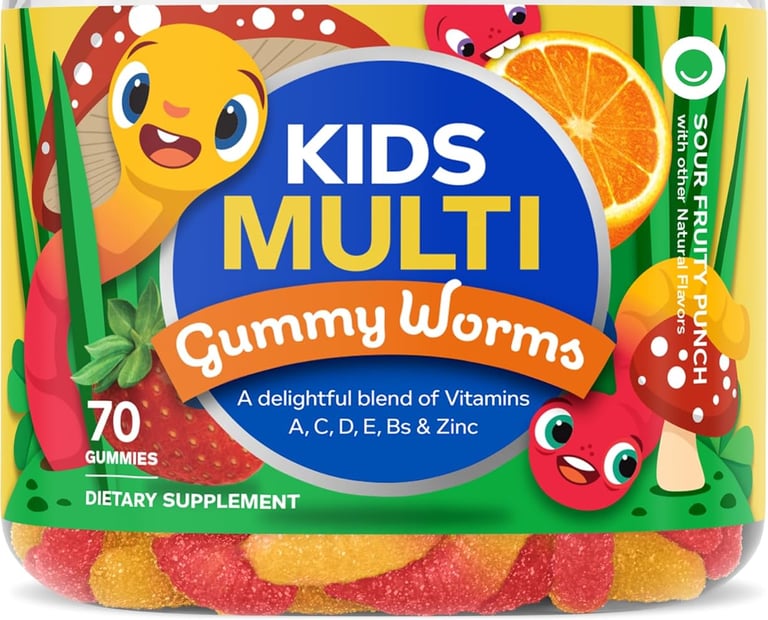Promoting Balanced Nutrition and Physical Activity for Children: A Comprehensive Guide
KIDSPARENTINGNUTRITION
9/1/20248 min read


Introduction to Children's Balanced Nutrition and Physical Activity
Ensuring that children receive a balanced nutrition and engage in regular physical activity is critical to their overall health and well-being. In an era where processed foods and sedentary lifestyles are increasingly common, fostering healthy eating habits and encouraging an active lifestyle from a young age can set the foundation for lifelong wellness.
Balanced nutrition is essential for children's growth and development. It provides the necessary vitamins, minerals, and nutrients that their bodies need to function optimally. This guide will delve into essential aspects of promoting balanced nutrition, such as the importance of reducing sugar intake, the benefits of introducing plant-based diets, and the advantages of involving children in meal planning.
First and foremost, reducing sugar intake is crucial for preventing a host of health issues, including obesity, diabetes, and dental problems. Educating children on the dangers of excessive sugar consumption and offering healthier alternatives can significantly impact their long-term health.
Furthermore, the introduction of plant-based diets can be immensely beneficial. These diets are not only rich in essential nutrients but also help in instilling appreciation for a variety of foods from an early age. Including an array of fruits, vegetables, whole grains, and legumes can ensure that children consume a diverse, nutrient-dense diet.
Involving children in meal planning is another effective strategy. When children participate in choosing and preparing their meals, they are more likely to develop healthier eating habits and make informed food choices. This collaborative approach can also be a bonding experience and an educational opportunity for families.
In addition to nutrition, physical activity is a vital component of a child's health regimen. Regular exercise helps in maintaining a healthy weight, strengthening bones and muscles, and improving mental health. Encouraging children to be active through play, sports, or structured exercises is essential for their physical and emotional development.
This comprehensive guide aims to provide invaluable insights and practical strategies for promoting balanced nutrition and physical activity among children. Through collective efforts, we can foster a healthier, more active generation.
Promoting Healthy Eating Habits in Children
Establishing healthy eating habits in children is fundamental to their long-term wellbeing. As caregivers, it’s crucial to set a positive example by demonstrating the importance of a balanced diet. Children often emulate the behaviors they observe at home, so consuming nutritious foods like fruits, vegetables, and whole grains visibly can significantly influence their dietary choices.
Creating a positive mealtime atmosphere is another vital aspect of encouraging healthy eating habits. Mealtimes should be viewed as an enjoyable opportunity for family bonding rather than a chore. Avoiding distractions such as television or mobile devices during meals allows children to focus on their food and develop mindful eating habits. Engaging in conversations about the day's events can enhance the mealtime experience further, making it a cherished routine.
Introducing a variety of foods gradually can encourage children to embrace diverse diets. Rather than pressuring them to try new foods, parents can adopt a patient approach, offering small portions of unfamiliar items alongside their favorite dishes. This slow integration helps children become accustomed to different textures and flavors, promoting a more balanced and inclusive diet over time.
Incorporating children in meal preparation can also spark an interest in healthy eating. Allowing them to assist with simple tasks like washing vegetables or stirring ingredients fosters a sense of involvement and excitement about their meals. This participation can cultivate a positive attitude towards food and nutrition, paving the way for lifelong healthy eating practices.
The long-term benefits of nurturing healthy eating habits in children are substantial. A balanced and nutritious diet supports optimal physical development, cognitive growth, and emotional well-being. By instilling these habits early, caregivers lay the foundation for a health-conscious lifestyle that children are likely to carry into adulthood. Through consistency, patience, and active involvement, fostering healthy eating behaviors becomes a rewarding endeavor that benefits children’s overall health and happiness.
Strategies for Reducing Sugar Intake
A critical aspect of promoting balanced nutrition for children is the effective management of their sugar intake. Excessive sugar consumption is linked to several health issues, including obesity, diabetes, and dental problems. Hence, it is imperative to understand the sugar content in foods, identify hidden sugars, and select healthier alternatives to reduce sugar intake systematically.
Initially, understanding nutritional labels plays a significant role. Parents and caregivers should be trained in reading food labels to determine the amount of sugar in various products. Ingredients like high-fructose corn syrup, sucrose, and glucose are indicators of added sugar. Moreover, it is beneficial to compare different brands to choose those with lower sugar content.
Hidden sugars, often present in unexpected products, pose another challenge. Items like cereals, sauces, and even bread can be laden with sugars, despite not being immediately recognizable as sweet treats. Terms such as "agave nectar," "cane juice," and "malt syrup" camouflage the presence of sugar. By becoming familiar with these aliases, parents can better manage their children's sugar consumption.
Adopting healthier alternatives is another effective strategy. Replacing sugary snacks with fruits, vegetables, or whole grains can significantly cut down sugar intake while providing essential nutrients. Introducing natural sweeteners like honey or maple syrup in moderation can also serve as a less harmful substitute for refined sugars. Additionally, promoting the consumption of water, milk, and unsweetened beverages over sugary drinks like sodas and juices contributes to sound health.
The health risks associated with high sugar consumption extend beyond immediate concerns like tooth decay. Long-term effects include a heightened risk of developing obesity and Type 2 diabetes. Therefore, instilling healthy dietary habits from childhood can act as a preventive measure, fostering a lifetime of better health and well-being.
Introducing Plant-Based Diets to Children
The incorporation of plant-based diets into children's daily nutrition offers numerous benefits, promoting overall health and well-being. Plant-based foods are rich in essential vitamins, minerals, and antioxidants, making them an excellent choice for growing children. These diets can also assist in reducing the risk of chronic diseases, fostering long-term healthy eating habits from an early age.
To successfully introduce plant-based meals to children, it is essential to adopt a balanced and appealing approach. Start by integrating familiar foods and gradually expanding their variety. For instance, replace traditional snacks with vegetable sticks, hummus, or fruit slices. Familiar comfort foods such as pasta can be prepared with vegetable-based sauces or plant-based proteins like lentils and chickpeas. Engaging children in the meal preparation process can also make them more receptive to new foods; an interactive approach can spark curiosity and positive associations with plant-based diets.
One of the primary concerns regarding plant-based diets for children is ensuring they receive adequate protein and essential nutrients. Legumes, nuts, seeds, and whole grains are excellent sources of plant-based proteins, which are crucial for growth and development. Additionally, foods fortified with vitamins B12 and D, and calcium-rich options such as broccoli, kale, and fortified plant milks, can adequately meet their nutritional needs. Omega-3 fatty acids, important for cognitive development, can be sourced from flaxseeds, chia seeds, and walnuts.
Addressing these nutritional concerns requires a thoughtfully planned diet that includes a diverse range of foods. Regular monitoring and occasional consultations with healthcare professionals can ensure that the child's dietary requirements are consistently met. Encouraging children to embrace a variety of plant-based foods can create a diet that is not only nutrient-dense but also enjoyable and satisfying.
Involving Children in Meal Planning and Preparation
Engaging children in meal planning and preparation offers a multitude of benefits that extend far beyond the kitchen. Encouraging children to take an active role in creating meals can help develop healthier eating habits, foster a better understanding of nutrition, and strengthen familial connections. By making the experience educational and enjoyable, parents can turn cooking and planning into valuable learning opportunities.
One of the primary advantages of involving children in meal preparation is the cultivation of improved eating habits. When children have a hand in choosing and preparing their meals, they are more likely to develop a preference for wholesome, nutritious foods. This engagement can lead to a greater willingness to try new foods, particularly fruits and vegetables, and an overall balanced diet. Moreover, the sense of accomplishment that comes with contributing to meal preparation can make healthy choices more appealing.
Introducing children to age-appropriate tasks in the kitchen also serves as a practical education in nutrition. Simple activities such as washing vegetables, mixing ingredients, or setting the table can provide a fundamental understanding of food and its origins. As they grow older, children can be involved in more complex tasks like measuring ingredients, reading recipes, and even grocery shopping. This hands-on experience helps them learn about portion sizes, food groups, and the importance of a varied diet, laying the foundation for lifelong healthy eating habits.
Beyond the benefits of improved nutrition and education, involving children in meal planning and preparation can also enhance family bonds. The kitchen can become a space for collaboration and communication, fostering teamwork and creating cherished memories. Shared meal preparation time offers an opportunity for parents and children to discuss food preferences, learn about cultural dishes, and even pass down family recipes. This interaction not only strengthens relationships but also instills a sense of responsibility and cooperation.
Incorporating children into the meal planning and cooking process does not have to be complicated. Start with simple tasks and gradually introduce more complex responsibilities as their skills develop. The key is to make the experience enjoyable and educational, ensuring that children feel valued and empowered in their contributions. By involving children in meal planning and preparation, parents can promote balanced nutrition, enhance understanding, and build stronger family connections, paving the way for a healthier future.
The Role of Physical Activity in Children's Health
Physical activity plays a crucial role in the overall health and development of children. Regular physical activity not only contributes to physical well-being but also enhances mental and emotional health. Numerous scientific studies corroborate these benefits, underscoring the importance of integrating exercise and active play into children's daily routines.
Engaging in regular physical activity helps in maintaining a healthy weight, reducing the risk of obesity, and promoting cardiovascular health. According to the World Health Organization (WHO), children who are physically active have stronger muscles and bones, a better immune system, and lower levels of body fat. These benefits are critical during the formative years, setting a foundation for a healthy future.
Beyond physical benefits, exercise significantly impacts mental health. Regular physical activity has been shown to improve mood, reduce anxiety and depression, and enhance cognitive abilities. Children who participate in physical activities often exhibit better concentration, memory, and classroom behavior, contributing to academic success. Engaging in team sports also helps in developing social skills, teamwork, and leadership abilities.
Different age groups require varying forms of physical activity to meet their developmental needs. Young children benefit from unstructured play, such as running, jumping, and playing games that stimulate their imagination. For preschoolers, activities like riding tricycles, dancing, or tumbling can be both enjoyable and beneficial. School-aged children should engage in more structured physical activities, such as swimming, soccer, or martial arts, which not only provide exercise but also teach discipline and teamwork.
Consistency and enjoyment are paramount in promoting a lifelong habit of physical activity. Activities should be enjoyable to the child to encourage regular participation. Parents and caregivers play a pivotal role by being active role models and incorporating physical activity into family routines. This not only helps in fostering a love for movement but also strengthens family bonds.
In conclusion, integrating regular physical activity into children's lives is essential for their physical, mental, and emotional development. With the support of scientific evidence and a wide variety of activities suited for different age groups, encouraging an active lifestyle is both manageable and highly beneficial.
Parenting
Empowering parents with essential child-rearing insights.
Support
Resources
contact@yipbeelife.com
© Yipbee Life 2024. All rights reserved.




